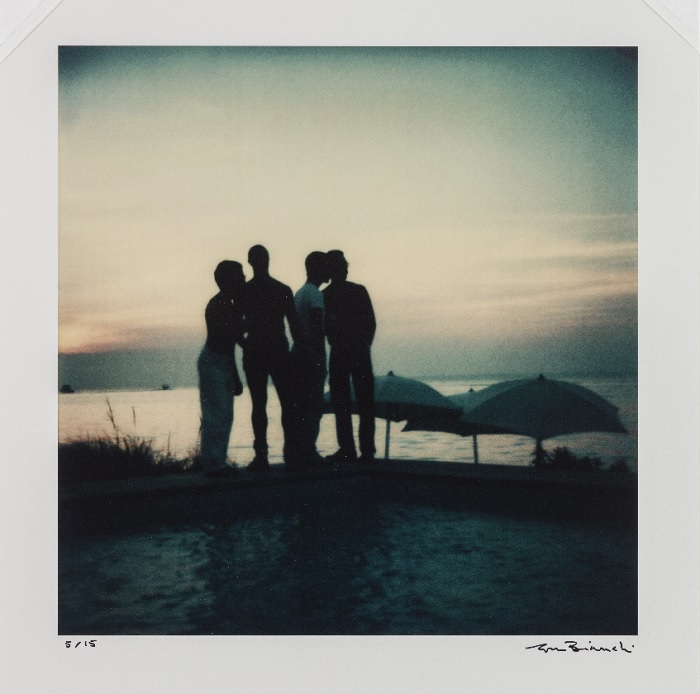
Tom Bianchi
American, 1945-
Untitled, 287, 1975-1983
archival pigment print, ed. 5/15
10 1/8 × 10 in.
SBMA, Museum Purchase with funds provided by Newman Family Fund (Charles and Betsy) and Mike and Elaine Gray
2017.34

Undated photograph, Fire Island
"In the 1970s I was a young New York lawyer given an SX-70 Polaroid by Columbia Pictures where I worked. I took the camera to my beach house at Fire Island Pines on weekends and recorded the life of the emerging gay community in this notorious place during the decade often referred to as Golden. We made our own good time on this sandbar physically removed and psychically remote from the America unable to come to terms with its gay citizens." - Tom Bianchi
COMMENTS
Tom Bianchi’s Polaroid images document the people, parties, and shared moments that defined Fire Island summers during those years, providing an intimate look at the Pines, a small close-knit gay beach community fifty-seven miles from New York City. The beautiful austere barrier island became a haven for the emerging gay community. As Tom Bianchi describes, it was “built by those people who imagined a different world and set out to create it. We carved out the tiniest little place just for ourselves, where we could be safe and laugh and play with one another on the beach, and not have any negative judgment surrounding us.” (Tom Bianchi Interview, Vice Magazine, June 2013)
Partly due to its close proximity to a culturally booming New York City, Fire Island attracted “the best and the brightest” of the gay community— artists, writers, models, photographers, designers, and actors came to the Pines each summer. The island became known not only as a safe summer enclave for gay men, but an exuberant and celebratory one. The summers Bianchi documented were a golden age, and remain the last fleeting moments before the AIDS crisis laid waste to an entire generation of men. The dream-like Polaroid images of dizzying parties and sculpted bodies can initially seem superficial, however the real people in these images dancing, kissing, holding hands, and playing in the sun are friends, lovers, and men creating a community where for the first time, they were free to love.
Tom Bianchi began photographing on Fire Island with a Polaroid SX-70 camera which proved to be the perfect tool— unassuming and immediate. Many of his friends and subjects, who were still closeted and extremely wary of having their picture taken, felt comfortable in front of both Bianchi and his camera. “At first, I shot subjects without identity to ensure anonymity for those who needed it, focusing on atmosphere. As time passed, friends became comfortable with the smiles on their faces being recorded. I quickly saw that I had the makings of a book. People saw what I was doing and came to welcome me, camera in hand.” (Tom Bianchi, Introduction to Fire Island Pines) Bianchi’s Polaroids exist now as precious relics from another time. The Polaroids have softly bent corners and subtle signs of wear, reminders that these photographs have the unique ability of being born in the same moment they documented. The friends and lovers in these pictures held the actual objects in their hands as they created the moments the images capture.
The sense of joy is so palpable in the scenes from the Pines that it is even more devastating to comprehend how violently this time came to an end. Bianchi describes AIDS as a holocaust that devastated a generation, a horror that forced these men to change the very way they saw themselves. In the context of the devastation and the discrimination that followed, Tom Bianchi’s heroic role in preserving this time has provided a vital layer of cultural and social history. The love and camaraderie captured on Fire Island during those summers is a record of the life and vitality lost to AIDS, and a reminder in the years that followed of what needed to be regained.
Tom Bianchi was born and raised in Chicago, graduating from Northwestern University of Law in 1970. While working as a corporate attorney in New York, Bianchi began visiting Fire Island every summer, photographing, painting, and drawing on the weekends. After Bianchi’s partner died of AIDS in 1988, Tom turned his focus towards photography, publishing Out of the Studio, a candid portrayal of gay intimacy. Tom went on to publish numerous successful monographs. In 1993, Tom co-founded a biotech company to develop new H.I.V./AIDS treatments. Tom Bianchi’s work has been exhibited and collected internationally. Tom Bianchi now lives and works with his husband Ben, in Palm Springs, California.
http://www.faheykleingallery.com/exhibitions/tom-bianchi
SBMA CURATORIAL LABELS
Tom Bianchi’s 1975-1983 photographs of summers in the Fire Island Pines off of Long Island, New York picture a rare place of freedom and pleasure for gay men that would all but vanish with the onset of AIDS as the 1980s unfolded. These five images are among hundreds that Bianchi originally took with an SX-70 Polaroid camera, one he was given via his corporate job in Manhattan. Bianchi would digitally transfer these Polaroids years later to create larger-scale prints as seen here. When they reappeared in this format in the 2000s— decades after their making in a world forever changed by the epidemic—the response to their apparent simpler-time cheer, courage, and joie-de-vivre was profound. The New York Times and the Washington Post ran major stories that cited these works’ sunny erotic charge and poignant significance in commemorating what Bianchi, who has lived and worked in Palm Springs since the 1980s, has called “a gay Brigadoon” and “one tiny bit of the world that was ours.”
- A Brilliant Spectrum, 2019
